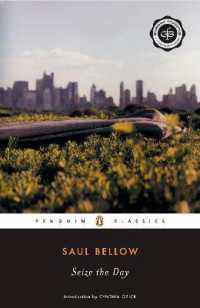Full Description
The Angry Earth explores how various cultures in different historical moments have responded to calamity, offering insight into the complex relationship between societies and their environments.
From hurricanes, floods, and earthquakes to oil spills and nuclear accidents, disasters triggered by both natural and technological hazards have become increasingly frequent and destructive across the planet. Through case studies drawn from around the globe the contributors to this volume examine issues ranging from the social and political factors that set the stage for disaster, to the cultural processes experienced by survivors, to the long-term impact of disasters on culture and society. In the second edition, each chapter has been updated with a postscript to reflect on recent developments in the field. There is also new material on key present-day topics including epidemics, drought, non-governmental organizations, and displacement and resettlement.
This book demonstrates the relevance of studying disaster from an anthropological perspective and is a valuable resource not only for anthropologists but for other fields concerned with education, policy and practice.
Contents
List of Figures and Tables
Acknowledgements
Note on Contributors
Introduction to the Second Edition of The Angry Earth: From Introduction to Widespread Reception (Susanna M. Hoffman and Anthony Oliver-Smith)
Introduction to the First Edition. Anthropology and the Angry Earth: An Overview (Susanna M. Hoffman and Anthony Oliver-Smith)
I. DISASTERS, ENVIRONMENT AND CULTURE
What is a Disaster? Anthropological Perspectives on a Persistent Question (Anthony Oliver-Smith)
Postscript: Hazards of Nature, Disasters of Society
II. ENVIRONMENTAL PATTERN, HAZARDS AND CULTURE: THE ARCHEOLOGICAL PERSPECTIVE
Convergent Catastrophes: Geoarcheological Perspectives on Collateral Natural Disasters and Cultural Change in the Central Andes (Michael E. Moseley)
Postscript: Convergent Catastrophe: Past Patterns and Future Implications of Collateral natural Disaster in the Andres
Explosive Volcanic Eruptions and Societal Responses: A Comparative Archeological Study in Middle America (Payson Sheets)
Postscript: When the Natural Hazard Becomes a Cultural Disaster
III. THE CULTURAL CONSTRUCTION OF CATASTROPHE
Peru's Five-Hundred Year Earthquake: Vulnerability in Historical Context (Anthony Oliver-Smith)
Postscript: The Five Hundred Year Earthquake: Seeking Root Causes and Deep Drivers
Examining Vulnerability to Natural Disasters: A Comparative Analysis of Four Southern California Communities After the Northridge Earthquake (Lois Stanford and Robert Bolin)
Postscript: Vulnerability Then and Now
The Negation of a Disaster: The Media Response to Oils Spills in Great Britain (Gregory V. Button)
Postscript: Continued Disavowal and The Advent of Social Media
IV. HOW CULTURES RESPOND
"The Worst of Times, the Best of Times": Toward a Model of Cultural Response to Disaster (Susanna M. Hoffman)
Postscript: Behind the States and Act Four: More to the Worst of Times, the Best of Times Model
Vulnerability, Disaster, and Survival in Bangladesh: Three Case Studies (Mohammad Q. Zaman)
Postscript: Integrated Approach to Risk Reduction and Development
"Tell Them We're Hurting": Hurricane Andrew, the Culture of Response, and the Fishing Peoples of South Florida and Louisiana (Christopher L. Dyer and James M. McGoodwin)
Postscript: Recognizing the Diversity of Disaster Impacts: The Need for Response Protocols, Anticipation, and Human Rights
Epidemics and Disasters: From the Venezuela Delta Amacuro to the Mississippi Wetlands (Charles Briggs and Anne M. Lovell)
Drought: A Challenge to Livelihoods, Sustainability, and Resilience (J. Terrence McCabe and Amy Quandt)
The Brotherhood of Pain: Emotion and Social Organization in the Crisis of Disaster (Anthony Oliver-Smith)
Postscript: Communitas and Resilience
The Regenesis of Traditional Gender Patterns in the Wake of Disaster (Susanna M. Hoffman)
Postscript: Still With Us After all These Years; But Slowly Changing
V. AGENCIES, SURVIVORS AND CULTURE
Plan and Pattern in Reaction to Earthquake: Peru, 1970-1998 (Paul L. Doughty)
Postscript: Revisiting a Scene of Disaster, Again
Bhopal and Beyond: An Anthropology of Relief and Rehabilitation Efforts and Prospects for a Socially Relevant Political Ecology of Disaster Management (Ravi Rajan)
Postscript: The Bhopal Gas Disaster Three Decades On
The Phoenix Effect in Post-Disaster Recovery: An Analysis of the Economic Development Administration's Culture of Response After Hurricane Andrew (Christopher L. Dyer)
Postscript: The Phoenix Effect Revisited: Hurricane Andrew, South Florida, and the Rise of Punctuated Entropy
Disaster Anthropology in Non-Governmental Organizations (Adam Koons)
Disaster and Climate Change-related Displacements and Resettlements: Cultural and Political Ecologies of Space, Power, and Practice (A.J. Faas, Roberto Barrios, Elizabeth Marino, and Julie Maldonado)
VI. DISASTER AND CULTURAL CONTINUITY
Islands on an Angry Earth: Climate Change, Disasters, and Implications for Two Island Communities (Heather Lazrus and Carlos Arenas)
After Atlas Shrugs: Cultural Persistence and Perpetuation in the Context of Disaster (Susanna Hoffman)
Postscript: The Question of Culture Continuity and Change After a Disaster Twenty Years Later
Index






